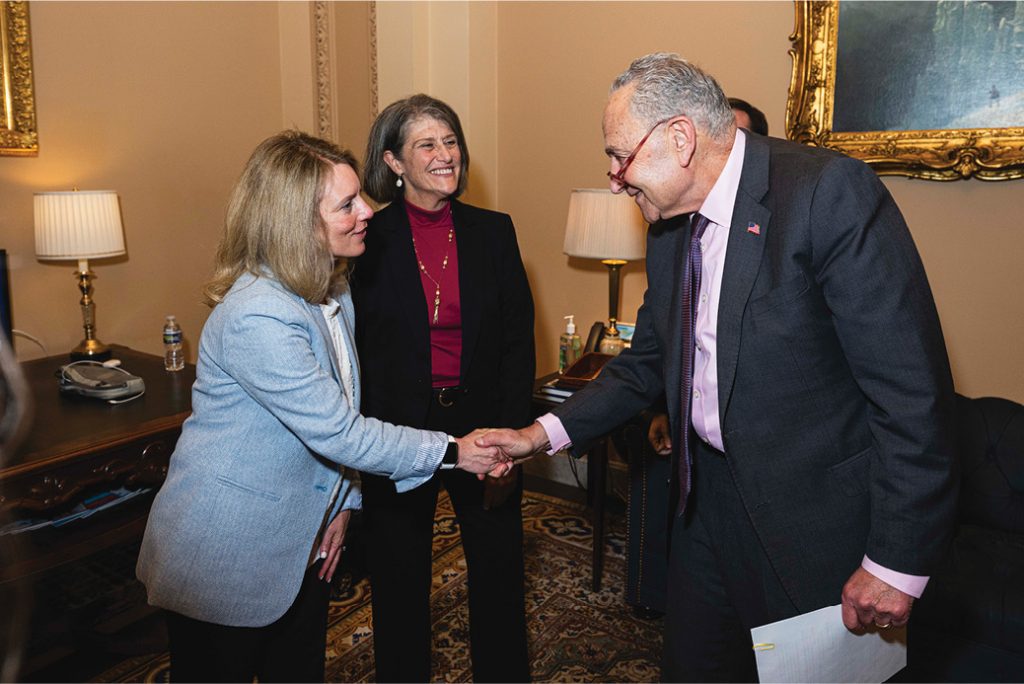At the end of a cul-de-sac, wrapped in a gallery of trees, the only sound you could hear on winter weekends was the scratching of skate blades carving into the surface of the frozen lake. It was here, gliding along this stretch of ice beside her aunt’s house in Ridgefield, CT, that Denise Stranko’s connection to nature was set. “You can’t imagine a more picturesque setting,” she said.
It seems fitting that Denise’s journey, like most that begin on a body of water in Fairfield County, would lead her to Long Island Sound. Though her path to Save the Sound, where she recently completed her first year as executive vice president of programs, wasn’t quite as straightforward as hitting the Norwalk River and heading south.
“It was something I knew even in college: that working with nature, with water in particular, had to be something I would do with my life,” said Denise, whose introduction to environmental policy came at SUNY Albany. What sounded like a class interesting enough to register for blossomed into her professional mission. “I remember being really impacted by that class. We talked about people tearing down the rainforest, all the heavy-duty pollution being directed into our waterways. We learned about all the overuse of our natural resources, and I thought, ‘We can’t have that.’”

Denise met with U.S Senator Chuck Schumer at the Capitol when the Long Island Sound Study Citizens Advisory Committee visited DC back
As a state attorney, she went on to fight for more significant penalties for municipalities and businesses polluting Maryland’s waters – “Maryland’s version of the Clean Water Act,” Denise called it. The pen from the 2002 signing ceremony in which House Bill 5 became state law remains encased in glass and displayed on the wall of her home office, a constant reminder of how progress happens.
Later, she worked within a broad coalition of partners to drive the Environmental Protection Agency to establish the Chesapeake Bay Total Maximum Daily Load. A TMDL represents the threshold for the amount of a particular pollutant that a waterbody can withstand and still meet water quality standards (Long Island Sound has one, too). The TMDL adopted by the EPA in 2010 was the agency’s largest, applying to all 64,000 square miles of the Chesapeake Bay watershed. That’s the kind of impact the former federal legislative and policy manager for the Chesapeake Bay Foundation is looking to make for Long Island Sound.
“My biggest goal is to bring some of what I learned working on the development and implementation of the Bay TMDL to the watershed work that is being done on Long Island Sound,” she said.
Denise is doing that through her work at Save the Sound, where she oversees its water quality, ecological restoration, land preservation, climate, and environmental justice teams and collaborates with the legal team. She’s doing it through her work on the Long Island Sound Study Citizens Advisory Committee, which is focused on shaping and implementing the Comprehensive Conservation and Management Plan to protect and restore the Sound region.
And every so often, her new role brings her back to Delmarva. Back in October, Denise joined the Citizens Advisory Committee on a trip to Washington, D.C. The CAC met with Senators and Congressmembers, encouraging the reauthorization of the Long Island Sound Restoration and Stewardship Act, which would bring $65 million of federal funding annually to support water quality and shoreline restoration. Denise and the Save the Sound contingent spoke for the CAC on such projects as the Unified Water Study, which measures the ecological health of 44 bays and harbors around the Sound; the push to preserve Plum Island as a national monument; and the ongoing Lobster Trap Retrieval and Assessment Partnership that in its first year recovered more than 1,000 abandoned lobster traps from the floor of Long Island Sound.
Her unique path has provided Denise with a big picture perspective on addressing massive and complex environmental challenges. With the Clean Water Act as her north star, Denise focuses on harnessing the collective power of all stakeholders – all the programs at Save the Sound, all the diverse coalition partners, all the policy leaders at the federal, state, and local levels – to serve as a community of stewards for Long Island Sound. In her vision, we all have a role to play.
“It’s a whole-watershed approach,” said Denise. “Protecting a watershed is not just about stopping the pollutants running into the water. It’s air pollution, it’s plastic waste. There are so many factors, and I think we have to look at ourselves the same way, as multifaceted individuals who can each find a way to do something. You may not be a lawyer or work in policy, but you can take your passion for a healthy environment and combine that with your own skillset. Every single one of us has a talent that can contribute to the overall mission.”
Visit SavetheSound.org to learn more. ■
